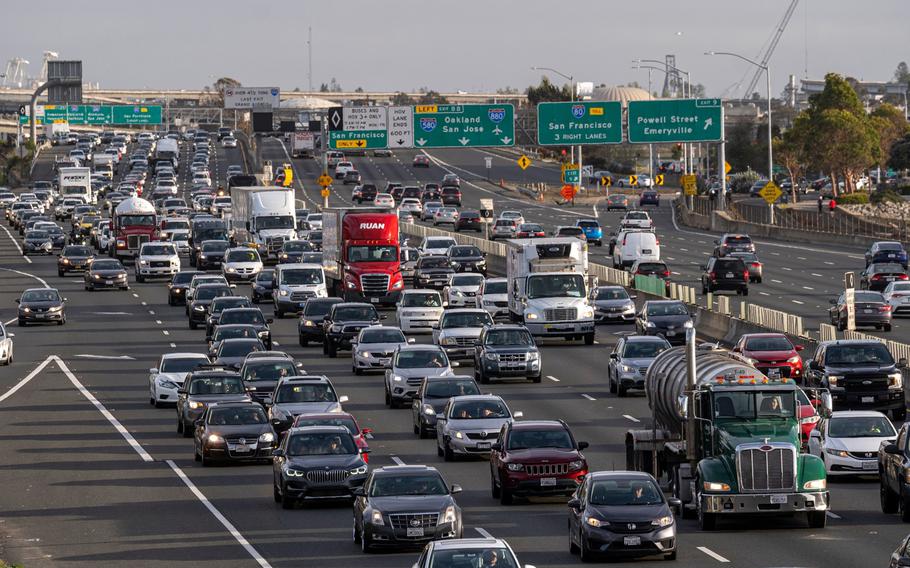
Vehicles head eastward on Interstate 80 in Emeryville, Calif., on March 29, 2022. The Biden administration on Friday, April 1, ordered carmakers to increase their average fuel economy to about 49 miles per gallon by 2026, (David Paul Morris/Bloomberg )
The Biden administration ordered carmakers to increase their average fuel economy to about 49 miles per gallon by 2026, in an ambitious effort to make up for progress stalled when President Donald Trump rolled back the efficiency program.
The new fuel economy rules, issued Friday by the National Highway Traffic Safety Administration, require carmakers to heighten the fuel-efficiency of their fleets by 8% annually for the 2024 and 2025 model years, and 10% for 2026, according to a senior administration official. The agency was facing a March 31 deadline to finalize new rules for the 2024 model year.
The new rules come as the Biden administration is struggling to combat rising gasoline prices with costs surging past $4 a gallon in the wake of Russia's invasion of Ukraine. The average price on Thursday was $4.22 per gallon, according to the American Automobile Association.
The administration had previously replaced a Trump fuel economy rule that called for automakers to make a 1.5% increase in fuel economy annually.
The U.S. Environmental Protection Agency has separately issued greenhouse gas emission regulations that require automakers to achieve a vehicle mileage of 52 miles per gallon by 2026 across all models they make, up from 40 mpg this year. The EPA's number equates to roughly 41 mpg in so-called real-world driving conditions that typically account for about a 20% drop in fuel economy from EPA's ratings.
The 49 mpg standard that the automobile industry will have to meet by 2026 is actually a testing figure. In real-world driving, the number would be about 39 mpg.
The EPA has said its proposal would result in a 10% reduction in vehicle emissions in model year 2023 and then a 5% greater emissions reduction improvement each year after through 2026. The agencies measure pollution differently, with the EPA focusing on tailpipe emissions and the NHTSA rules centering on miles-per-gallon.
Steven Croley, chief policy officer and general counsel of Ford, said in a statement on Thursday night that "Ford applauds NHTSA's efforts to strengthen fuel economy standards and create consistent benchmarks to accelerate our national transition toward a zero-emissions transportation future."
The EPA reported in November 2021 that carmakers achieved an average of 25.4 miles per gallon for vehicles made during the 2020 model year. That was 0.5 mpg higher than the 2019 model year and a record high, but a far cry from the 39 miles-per-gallon, in real-world terms, by 2026 that President Joe Biden's administration is now proposing.
Under the administration's proposal, auto manufacturers will retain the ability to purchase credits from electric vehicle makers, like Tesla Inc., to ensure compliance with the fleetwide mileage requirements. The car companies say the credit system aids the industry's transition to fully electric vehicles.
A group of 15 states led by conservative Republican governors has filed a lawsuit over the EPA's rules that argues the agency exceeded its authority and violated the U.S. Constitution's separation-of-powers principles in setting the stringent greenhouse gas emission rules. The case was filed in December by Texas, Alabama, Alaska, Arkansas, Indiana, Kentucky, Louisiana, Mississippi, Missouri, Montana, Nebraska, Ohio, Oklahoma, South Carolina, and Utah.
The regulations from both agencies are part of a Biden plan that calls for half of all vehicles sold in the U.S. to be capable of emissions-free driving by the end of the decade, an ambitious goal that automakers say can only be achieved with bigger government investment in charging stations and other infrastructure.